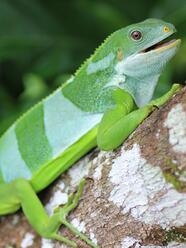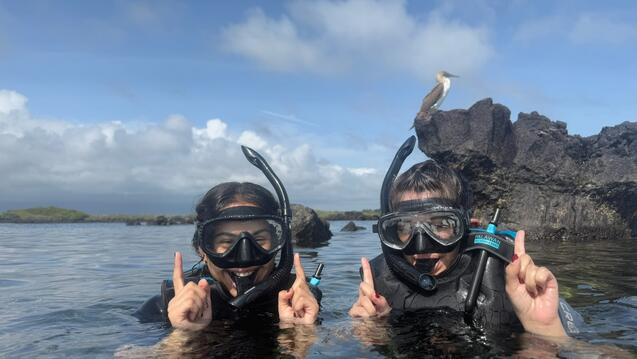
USF Professor Publishes Research on Iguanas That Rafted to Fiji

It sounds like an idea for Pixar’s next animated film: Land-loving iguanas from North America float to Fiji on dislodged trees that formed rafts for the reptiles.
In reality, though, it’s big news in the science community. Professor Simon Scarpetta is the lead author on a study, published last month in Proceedings of the National Academy of Sciences, that suggests iguanas from North America ended up in Fiji sometime within the past 34 million years by floating 5,000 miles.
Scarpetta, an evolutionary biologist, paleontologist, and herpetologist, teaches conservation biology, ecology, and several lab courses at USF. His students are excited about the international media attention the iguana research has received, he said.
“They’ve been pretty stoked,” Scarpetta said. “They said, ‘Wait a second, you’re on the news.’ It’s been really great to have students excited about it.”

Why iguanas?
I grew up in Albuquerque, New Mexico, in the high desert catching lizards and frogs since I was 2. This particular group of lizards has been a lifelong thing for me.
Also, several members of my family are Colombian, and I have many memories of going to Colombia to visit, and definitely spent time catching iguanas.
That continued into research, and it was serendipitous that I worked in a lab in high school that focused on lizards at the University of New Mexico.
Describe the results of the study.
Our analyses of genome-wide DNA sequence data found that Fijian iguanas are most closely related to North American desert iguanas. Then, we performed multiple analyses to date the evolutionary divergences among iguanas. These divergence dates were estimated with DNA sequences, and the fossil record was used to calibrate genetic differences to time. We found that Fijian iguanas and North American desert iguanas likely diverged from each other between 31 and 34 million years ago.
Finally, we ran biogeographic models to find the most likely area of origin for Fijian iguanas and mechanism for how they got there. These models strongly supported North America as the area of origin for Fijian iguanas, and that a long-distance dispersal event within the past 34 or so million years was most likely how they arrived. That dispersal was a roughly 5,000-mile rafting event from North America to Fiji, the longest known transoceanic dispersal in a terrestrial vertebrate.
What made you think of rafts?
How iguanas got to Fiji was one of those evolutionary problems that no one had been able to figure out. For my current research program, I collected DNA sequences of iguanas and many of their relatives, including horned lizards and bearded dragons. The first thing I saw when I was looking at the broader results was that the Fijian iguanas were most closely related to the desert iguanas in the southwest United States, which was pretty cool. That sort of initial “aha” was the impetus to start the project. But how on earth would they have gotten there?
Other species have also migrated one from place to the other via oceanic rafting. Evolutionary biologists have called it a sweepstakes dispersal. You have to win the sweepstakes to get on a raft and get to another location.
How would the iguanas have survived on the ocean?
If you had to pick an animal that would do this over and over again, it would be iguanas. They’re ectothermic (sometimes referred to as “cold-blooded”) and so require less energy to survive compared to mammals, for example. Many iguanas are particularly resistant to starvation, and some are resistant to dehydration and to heat, too. Moreover, iguanas are herbivorous and so the ancestors of Fijian iguanas may have had food built into their raft.
People have seen iguanas rafting on dislodged trees to get from one place to another. After several hurricanes in 1995 in the Caribbean, green iguanas made it almost 200 miles from the island of Guadeloupe to the island of Anguilla.
If you had to think of what animals could make that journey? Iguanas.
The study was conducted in collaboration with researchers at the University of California, Berkeley; Villanova University; the U.S. Geological Survey; and NatureFiji-MareqetiViti. Scarpetta was supported by a National Science Foundation postdoctoral research fellowship.



